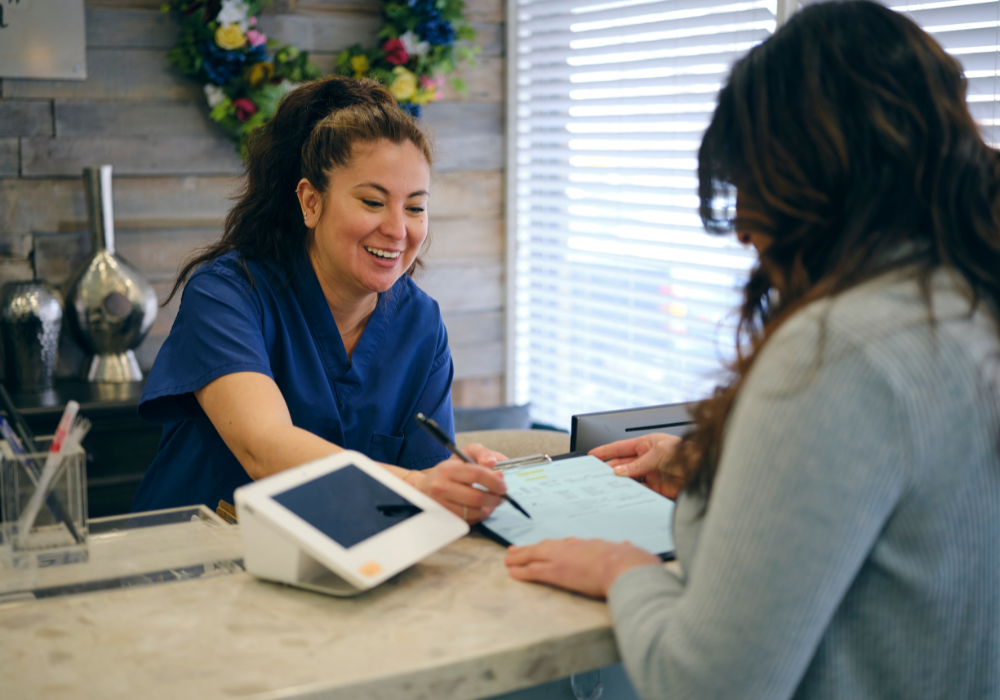Actions Speak Louder Than Words: Understanding Body Language
Posted by EyePromise on Mar 28th 2024
We’ve talked about the importance of word choice, now let’s talk about what’s not said. People communicate a lot through body language, and understanding what certain positions, stances, movements, and motions mean can help you better communicate with patients. Sharon Carter, ECOC, has honed her skills over 30+ years of working in optometry, and here’s what she recommended in an article for Independent Strong.
Touch
As a vital sense, we forge many relationships through touch. In healthcare, this most commonly looks like a handshake, which can tell your patients a lot about you and vice versa. A good handshake can instill trust and reassure the patient that you’re present in the moment. According to an article on Etiquette for the Business of Life, an effective handshake has three phases.

The Reach
In a great handshake, the webbing of the hand between the thumb and the index finger should be the first to meet. This requires both parties to extend their open hands with the thumb pointing up. The speed of the reach is important, too, as too quick can startle or come off as hurried and too slow conveys disinterest or uncertainty.
The Clasp
As soon as the “web-touch” occurs, most naturally find themselves moving to “the clasp” phase. As the palms meet, the fingers wrap around the hand you’re shaking with a firm grip but not tight. The critical part of this phase is eye contact. Once the palms have met, make sure you’re getting your eyes up to meet your patient’s!
The Shake
Once the hands are connected, it’s time for “the shake” phase. The keys for success lie in the number of times your hands go up and down (i.e., the shake) as well as the vigor in which you move the hands. Moving the hands up and down a couple of times is typical, but don’t extend it past three shakes. The vigor of the shake is a fine balance. Too much and you can appear overly confident or frightening for a patient. Too little and it’s giving “dead fish.”
Facial Expressions
Facial expressions are one of the easiest to read of the body language tells. Is the patient smiling or frowning? Do they look confused or disinterested? Your face also tells them what you’re feeling. Are you walking into the exam room looking tired or do you enter with bright eyes and a smile on your face?
Another important part of communicating is eye contact. It can display sincerity and confidence, but too much eye contact can make a patient feel uneasy. Try maintaining eye contact for 70% of the interaction, taking opportunities to glance away every now and then to look at educational material, the patient’s test, or away enough to break the awkwardness.
Body Expressions

Unlike facial expressions, body expressions can be more difficult to read and even more challenging to understand. This is because different people react differently, and it can be hard to tell what the true meaning is behind a person’s stance or action without knowing the person well. However, there are a few general expressions that convey certain messages.
Crossed arms can suggest negativity, defensive, or unapproachable, as they create a physical barrier between you and the patient. It can also come across as pensive, but unless the patient is familiar with you, it’s best to steer away from crossing your arms while with them.
Posture is another avenue for body language. Is the patient sitting upright in the chair? Are they fidgeting? Did you walk into the exam room with your head high or did you kind of shuffle in? Being conscious of your actions can help improve the overall patient experience.
Pitch
Pitch is considered “body language” because it’s not directly the words used to communicate and is another more difficult mode of communication to understand as it, too, varies for people. For example, monotone conversations can be more difficult to maintain interest, but that’s just the way some people talk. Until your patients become more regular and can understand, it’s best to try and vary your inflection.
The volume at which you speak can also communicate a lot. Softness can come across as unsure, whereas loudness can convey power, which can be off putting. It’s another area where balance is imperative.
Creating the Right Patient Experience

Now it’s time to put these recommendations into action. From the moment the patient walks into your office, they assess the look, the atmosphere, and yes, the people. That split-second first impression can set the tone for the rest of their office visit, so it’s critical your front desk staff knows how to portray themselves in the manner that you expect.
Many practices offer scripting for their staff to ensure they’re communicating exactly that the practitioner intends, but the non-verbal cues discussed above can make or break that message. A staff member who greets patients with a smile and excitement in their voice will deliver a positive message, while a staff member who doesn’t make eye contact and appears to be reciting a rehearsed line can be a quick turnoff.
On the other hand, being able to read a patient’s body language can help keep a situation from escalating. While you’re talking with the patient, are they leaning away from you? Are they crossing their arms and shifting in the chair? Are their eyebrows furrowed? Recognizing these signs of distress and shifting your approach can help keep patients engaged and ensure their experience in your practice is a positive one.
How Can an EyePromise® Partnership Help?
As an all-encompassing nutrition partner, EyePromise offers more than just clinically proven nutraceuticals. Your success is our success, so we offer in-practice and remote trainings to help your staff feel comfortable and confident when talking about the program. Additionally, we provide scripting, so you and your staff know what to say, and we practice it with you, so you know how to say it, too. To learn more about becoming an EyePromise partner, have you local Regional Account Manager contact you!
Words can say a lot, but what you don’t say can be an even bigger tell. Make sure your entire office is aware of not only what they’re doing, but what it can communicate to patients.

